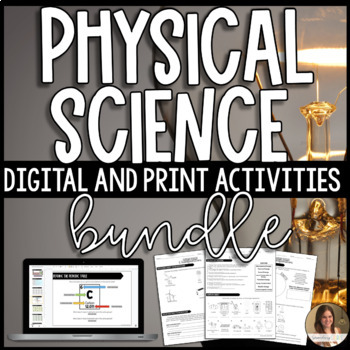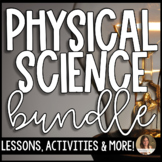Physical Science Activities Bundle - Google Slides™ and Print
- Zip
- Google Apps™
- Internet Activities

Products in this Bundle (13)
showing 1-5 of 13 products
Also included in
- Save over 20% with this resource that includes all of my physical science activities including PowerPoints, Guided Notes, Assessments, Warm Ups, Self-Grading Task Cards, Choice Boards, Interactive science notebook Google Slides and Print Activities, Labs, Stations activities, project-based learningPrice $266.00Original Price $332.50Save $66.50
- This bundle contains print and digital interactive science notebook resources that use Google Slides for middle school science. There are 6-10 interactive activities in each resource to review middle school science topics in Earth/Space, Life Science, and Physical Science.Use these activities for:SuPrice $122.20Original Price $152.75Save $30.55
Description
This is a bundle of print and digital science interactive notebook resources that use Google Slides for a middle school physical science class. There are 6-7 interactive activities for each unit including matter, energy, force and motion. The activities vary depending on the unit. A video preview is available for each activity to show demonstrate what you will be getting and how they work.
Use these activities for:
- Sub Plans
- Test Prep (Florida SSA, Texas STAAR, NGSS)
- Online Learning
- Homework
- Independent review
- Stations
- Interactive Notebook Activity
- Early Finishers
Students will practice vocabulary skills, make real-world connections, research independently, understand visual representations and review concepts.
The activities include either drag and drop or short answer text. Watch the preview video to get a better idea of how each slide works.
The slides and print versions are not editable. An answer key is included in the PDFs as well as the Google Slides links.
INCLUDED IN THE BUNDLE:
1. Pure Substances and Mixtures
This is a print and digital resource that uses Google Slides. There are 6 interactive activities to review Pure substances, elements, compounds and mixtures.
The activities include either drag and drop or short answer text. Watch the preview video to get a better idea of how each slide works.
Content covered:
⭐ Pure substances
⭐ Elements
⭐ Compounds
⭐ Mixtures (heterogeneous, homogeneous)
⭐ Solutions, colloids and suspensions
This activity is not editable.
2. Atoms and the Atomic Theory
This is a print and digital digital resource that uses Google Slides. There are 6 interactive activities to review Atoms and the Atomic Theory.
Students will review vocabulary, scientists contributions to the atomic theory, atomic numbers and calculate mass numbers.
The activities include either drag and drop or short answer text. Watch the preview video to get a better idea of how each slide works.
This activity is not editable.
Content covered:
⭐ Atoms
⭐ Atomic Structure and subatomic particle masses
⭐ Contributing scientists to the atomic theory (Democritus, Aristotle, John Dalton, J.J. Thomson, Ernest Rutherford, Erwin Schrödinger and Werner Heisenburg)
⭐ Isotopes
⭐ Atomic number
⭐ Mass number
3. Changes in States of Matter
This is a print and digital digital resource that uses Google Slides. There are 6 interactive activities to review states of matter and changes in states of matter.
Students will review vocabulary, phase changes, particle behavior and research.
The activities include either drag and drop or short answer text. Watch the preview video to get a better idea of how each slide works.
This activity is not editable.
Content covered:
⭐ States of matter (solid, liquid, gas)
⭐ Kinetic Theory of Matter
⭐ Thermal Energy
⭐ Changes in states of matter (Boiling, evaporation, condensation, melting, freezing, vaporization, sublimation, deposition)
⭐ Pressure and Temperature
4. Periodic Table
This is a print and digital resource that uses Google Slides. There are 6 interactive activities to review the periodic table.
Students will review vocabulary, elements in manufacturing/nature, reading the periodic table and using the periodic table to obtain information. A periodic table slide is included for students to use for reference.
The activities include either drag and drop or short answer text. Watch the preview video to get a better idea of how each slide works.
The slides are not editable.
Content covered:
⭐ What is the Periodic Table?
⭐ How to obtain information from the periodic table.
⭐ Dimitri Mendeleev and Henry Mosely.
⭐ Chemical name, chemical symbol, atomic number, average atomic mass.
⭐ Groups and periods.
⭐ Metals, nonmetals and metalloids.
⭐ Arrangement of elements.
⭐ How to determine if elements have similar properties.
5. Physical and Chemical Changes
This is a print and digital resource that uses Google Slides. There are 6 interactive activities to review the Physical and chemical changes.
Students will review vocabulary, indicators of physical changes and chemical changes, use supporting evidence and apply their knowledge to their daily lives.
The activities include either drag and drop or short answer text. Watch the preview video to get a better idea of how each slide works.
The slides are not editable. Answer key is included in the PDF as well as the Google Slides link.
Content covered:
⭐ Physical properties (mass, weight, volume, density, malleability, thermal conductivity, electrical conductivity, solubility, magnetism, luster, viscosity)
⭐ Chemical Properties (reactivity, flammability)
⭐ Physical changes
⭐ Chemical Changes
⭐ Law of Conservation of Mass
6. Scientific Investigations and Inquiry
This is a print and digital resource that uses Google Slides. There are 6 interactive activities to review scientific investigations and the scientific method.
Students will review vocabulary, real-world examples, independent and dependent variables and design a quick investigation.
The activities include either drag and drop or short answer text. Watch the preview video to get a better idea of how each slide works.
The slides are not editable. Answer key is included in the PDF as well as the Google Slides link.
Content covered:
⭐ Experiments vs Observations
⭐ Creating a Hypothesis
⭐ Variables (Independent, Dependent, Constant)
⭐ Scientific Method Steps
7. Forces and Newton's Laws Digital Google Slides Activities
This is a print and digital resource that uses Google Slides. There are 6 interactive activities to net force, Newton's laws of motion and balanced/unbalanced forces.
Students will review vocabulary, Newton's laws, create their own scenarios, calculate net force and practice identifying balanced and unbalanced forces.
The activities include either drag and drop or short answer text. Watch the preview video to get a better idea of how each slide works.
The slides are not editable. Answer key is included in the PDF as well as the Google Slides link.
Content covered:
⭐Calculating Net force
⭐Balanced & Unbalanced Forces
⭐Newton's Laws of Motion.
8. Energy Forms and Transformations Digital Google Slides Activities
This is a print and digital resource that uses Google Slides. There are 6 interactive activities to review energy forms and energy transformations.
Students will review vocabulary, forms of energy, create their own transformations, calculate net force and discuss the processes of energy transformation.
The activities include either drag and drop or short answer text. Watch the preview video to get a better idea of how each slide works.
The slides are not editable. Answer key is included in the PDF as well as the Google Slides link.
Content covered:
⭐Types of Potential Energy
⭐Types of Kinetic Energy
⭐Energy Transformations
⭐Law of Conservation of Energy
9. Mass, Volume and Density
This is a print and digital resource that uses Google Slides. There are 6 interactive activities to review measuring matter. These can be used as online stations, an activity for early finishers, homework or for review in the classroom.
Students will practice vocabulary skills, make calculations, make inferences, review measurement tools and use critical thinking to solve problems.
The activities include either drag and drop or short answer text. Watch the preview video to get a better idea of how each slide works.
The slides are not editable. An answer key is included in the PDF as well as the Google Slides link.
Content covered:
⭐Matter
⭐Mass
⭐Weight
⭐Volume
⭐Density
⭐Formulas and Calculating Mass, Volume and Density
⭐Water Displacement
10. Thermal Energy and Heat Transfer
This is a print and digital resource that uses Google Slides. There are 6 interactive activities to review thermal energy, conductors, insulators, conduction, convection and radiation. These can be used as online stations, an activity for early finishers, homework or for review in the classroom.
Students will practice vocabulary skills, make real-world connections and review concepts.
The activities include either drag and drop or short answer text. Watch the preview video to get a better idea of how each slide works.
The slides are not editable. An answer key is included in the PDF as well as the Google Slides link.
Content covered:
⭐Kinetic Theory of Matter
⭐Temperature
⭐heat
⭐Thermal Energy
⭐Transfer of Heat
⭐Conduction
⭐Convection
⭐Radiation.
11. Interactions of Light Waves
This is a print and digital resource that uses Google Slides. There are 6 interactive activities to review light wave interactions such as transparent, translucent, opaque, reflection, refraction and absorption. These can be used as online stations, an activity for early finishers, homework or for review in the classroom. Perfect for distance learning!
Students will practice vocabulary skills, make real-world connections and review concepts.
The activities include either drag and drop or short answer text. Watch the preview video to get a better idea of how each slide works.
The slides are not editable. An answer key is included in the PDF as well as the Google Slides link.
Content covered:
⭐Transparent, translucent, opaque
⭐Reflection, refraction and absorption
⭐What determines the color we see?
⭐Wavelength
12. Properties of Waves
This is a print and digital resource that uses Google Slides. There are 6 interactive activities to review wave properties such as wavelength, amplitude, frequency and wave speed. Students will also compare longitudinal and transverse waves as well as mechanical and electromagnetic waves. These can be used as online stations, an activity for early finishers, homework or for review in the classroom. Perfect for distance learning!
Students will practice vocabulary skills, make real-world connections and review concepts.
The activities include either drag and drop or short answer text. Watch the preview video to get a better idea of how each slide works.
The slides are not editable. An answer key is included in the PDF as well as the Google Slides link.
Content covered:
⭐Longitudinal vs Transverse waves
⭐Electromagnetic vs mechanical waves
⭐Measuring wavelength and amplitude of transverse waves
⭐Wave speed
13. Electromagnetic Spectrum
This is a print and digital resource that uses Google Slides. There are 6 interactive activities to review the electromagnetic spectrum such as the parts, vocabulary, frequencies, wavelengths, real-world application and more. These can be used as online stations, an activity for early finishers, homework or for review in the classroom. Perfect for distance learning!
Students will practice vocabulary skills, make real-world connections and review concepts.
The activities include either drag and drop or short answer text. Watch the preview video to get a better idea of how each slide works.
The slides are not editable. An answer key is included in the PDF as well as the Google Slides link.
Content covered:
⭐ What is electromagnetic radiation?
⭐ What is the electromagnetic spectrum?
⭐ Radio waves
⭐ Microwaves
⭐ Infrared
⭐ Visible Light
⭐ What determines the color of light?
⭐ Ultraviolet
⭐ X-rays
⭐ Gamma Rays
⭐ what role does the sun play?







